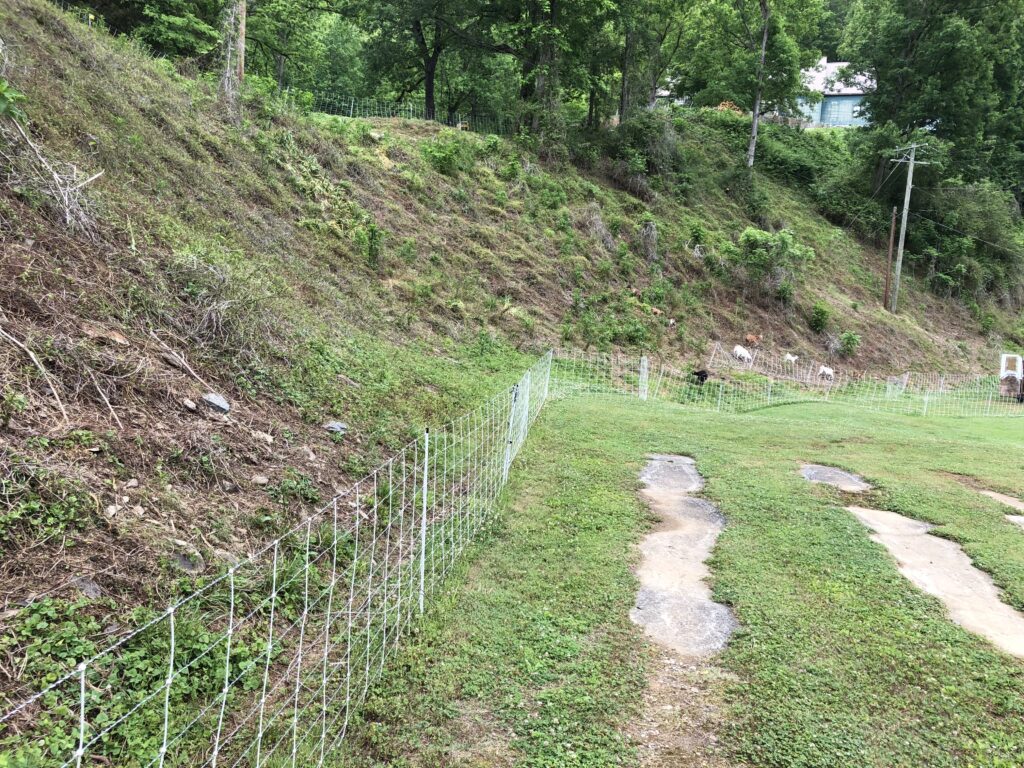Authors:
Julie Blaker, Pittman Center Firewise Committee Coordinator
Kristine Johnson, Pittman Center Bee City and Firewise Committees
Glenn Taylor, Pittman Center Firewise Photographer
USDA Plant Hardiness Zone: 6
Common invasive plants: kudzu, multiflora rose, garlic mustard, wisteria
Bee City of Pittman Center, TN, teamed up with the Pittman Center Firewise Committee for an innovative project combining wildfire fuel reduction, invasive exotic plant removal, and pollinator habitat enhancement. A Hazard Mitigation Grant from the Firewise program of Tennessee’s Division of Forestry provided funds to contract with Knox Goats, Inc., to provide a herd for most of summer 2021. The goats grazed a dense monoculture of kudzu on steep slopes below the Sevier County School System’s Eugene W. Huskey Environmental Center. Goats and sheep are becoming an increasingly popular alternative for invasive plant control and hazard fuel management because they are agile, sure-footed, and cause minimal soil damage. They consume a wide range of plants, so could not be used where non-target plants are a concern. However, on sites where an aggressive invasive species like kudzu forms a monoculture, grazers can be a good solution. Spraying the entire site with herbicide would have been difficult on steep terrain and would have killed non-target plants as well. Grazing removed heavy growth of the invasive species but allows native plants to grow from seed in the soil bank or root systems.

Kudzu is very flammable in any season and its dense growth prohibits construction of firelines by hand or even by bulldozers. The thick vines grow into and overtop tree canopies, creating fire ladders into forested areas. Buildings surrounded by kudzu, especially on steep slopes, are very vulnerable to wildfire. Firewise programs throughout the country encourage communities to reduce fuels around structures.


The goats were accompanied by large moveable electric fencing, food, water, shelter, and both human and canine guardians. Without protection they would be vulnerable to coyotes, bears, and other predators. The goats seemed to seek out kudzu first as a preferred food then move on to other species, and covered the area intently before the fencing was moved to a new section. By autumn, native plants were emerging and hazard fuels were greatly reduced for the upcoming fire season. People stopped to take pictures of the goats; the public and students at the environmental education center benefited from some new lessons on firewise landscaping, invasive plant control, and pollinators.

Pittman Center borders the Great Smoky Mountains National Park, home to over 1,700 species of flowering plants, 293 species of butterflies, 627 species of wasps, and 112 species of butterflies and skippers, according to National Park Service IRMA Portal (Integrated Resource Management Applications). New species are found every year as research continues into pollinator life cycles and plant- host requirements. Invasive exotic plants destroy habitat, displacing natives and forming monocultures that often can’t support native insects, birds and other wildlife. Some common native pollinator plants around the environmental center include asters, violets, tulip poplar, spicebush, phlox, buckeye, crossvine, and fruit trees. These are now seeding in and emerging in the area cleared by the goats.

Any invasive plant control project requires a sustained effort, particularly with deep-rooted species such as kudzu. Grazing removes the plant’s top but roots will continue to grow and more grazing or mowing will be needed in the future. The goats were fun to watch and did a great job!
Pittman Center is realizing there is much overlap between ecological programs and Firewise USA. An important part of the Firewise program is controlling non-native plant species and designing fire resistant perimeters around the homes and buildings. Kudzu is just one example of a non-native plant that increases local fire danger. Others include Bradford pear, privet, and honeysuckle, all of which disrupt the natural resiliency of native ecosystems. Safely living in wildland–urban interfaces requires having defensible space around structures and eliminating as much combustible material as possible within 5 feet of a structure. More information can be found online at seviercountyfirewise.com, the Pittman Center Firewise Committee’s Facebook page, or by searching online on Firewise topics.






